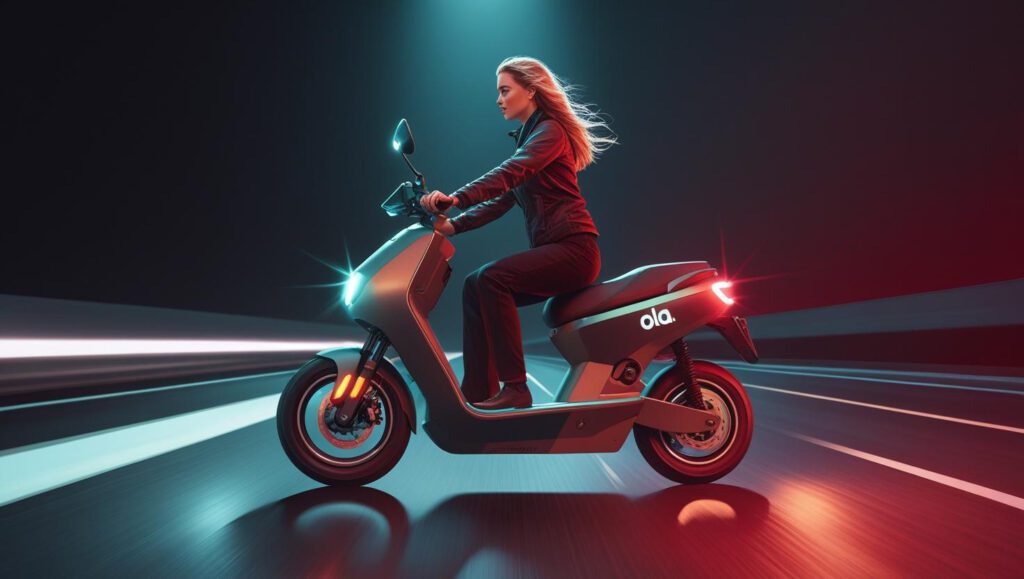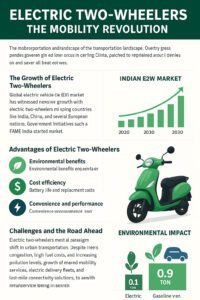The transportation landscape in India and globally is undergoing a radical transformation. One of the most visible and impactful shifts is the rise of electric two-wheelers (E2Ws). These vehicles, powered entirely by electricity, are rapidly redefining urban mobility, offering sustainable alternatives to traditional gasoline-powered scooters and motorcycles. From reducing carbon footprints to lowering running costs, electric two-wheelers are spearheading a mobility revolution that promises cleaner, smarter, and more efficient travel.
The Growth of Electric Two-Wheelers
The global electric vehicle (EV) market has witnessed unprecedented growth over the past decade, with electric two-wheelers taking center stage in countries like India, China, and several European nations. In India, where two-wheelers constitute over 75% of the total vehicle population, the adoption of electric alternatives is particularly crucial. Government initiatives such as FAME India (Faster Adoption and Manufacturing of Hybrid and Electric Vehicles) and subsidies on electric scooters have significantly boosted consumer interest.
According to recent industry reports, the Indian electric two-wheeler market is expected to surpass 10 million units by 2030, driven by urban demand, rising fuel prices, and increasing environmental awareness. Leading brands like Ola Electric, Ather Energy, Bajaj, TVS, and Hero Electric are investing heavily in advanced battery technology, performance optimization, and charging infrastructure, making electric two-wheelers more reliable and accessible.
Advantages of Electric Two-Wheelers
-
Environmental Benefits: One of the most compelling reasons for the shift to electric two-wheelers is their minimal environmental impact. Unlike petrol-powered bikes that emit harmful carbon dioxide and other pollutants, electric two-wheelers produce zero tailpipe emissions. This transition plays a critical role in reducing urban air pollution and combating climate change.
-
Cost Efficiency: Electric two-wheelers offer significant savings over conventional vehicles. Electricity costs per kilometer are substantially lower than fuel costs, and maintenance requirements are minimal due to fewer moving parts. Consumers can save thousands of rupees annually on fuel and servicing, making E2Ws an economically attractive option.
-
Convenience and Performance: Modern electric two-wheelers are designed for urban commuting with smooth acceleration, low noise, and hassle-free operation. With improvements in lithium-ion battery technology, many models now offer ranges of 80-150 km on a single charge, sufficient for daily commutes. Fast-charging solutions and swappable battery systems are further enhancing convenience for users.
-
Government Incentives: Policies supporting the adoption of electric vehicles, such as reduced GST rates, state-level subsidies, and incentives for battery manufacturing, have significantly lowered the upfront cost of electric two-wheelers. These measures are accelerating market penetration and making EVs a practical choice for middle-class households.
Challenges and the Road Ahead
Despite their benefits, electric two-wheelers face certain challenges. Charging infrastructure remains limited in many urban and semi-urban areas, creating concerns about range anxiety. Battery life and replacement costs, though improving, are still points of consideration for potential buyers. Additionally, widespread awareness and consumer confidence in electric mobility need further reinforcement through education and promotional campaigns.
However, the outlook is optimistic. The continuous decline in lithium-ion battery prices, advancements in energy density, and expansion of public and private charging networks are addressing these barriers. Companies are also exploring smart mobility solutions, such as app-based battery swapping, vehicle-to-grid integration, and AI-enabled fleet management, which further enhance the appeal of electric two-wheelers.
Impact on Urban Mobility
Electric two-wheelers are not just vehicles—they represent a paradigm shift in urban transportation. With rising congestion, high fuel costs, and increasing pollution levels, E2Ws provide a clean, efficient, and practical solution for city dwellers. They are also fostering the growth of shared mobility services, electric delivery fleets, and last-mile connectivity solutions, creating a ripple effect on urban planning and sustainable mobility strategies.
Moreover, the adoption of electric two-wheelers encourages a shift towards green energy consumption, as renewable energy sources like solar and wind are increasingly used to charge EVs. This integration of clean energy with mobility solutions signifies a step toward a more sustainable and resilient urban ecosystem.


